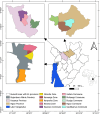Lack of knowledge of stakeholders in the pork value chain: Considerations for transmission and control of Taenia solium and Toxoplasma gondii in Burundi
- PMID: 40601613
- PMCID: PMC12221015
- DOI: 10.1371/journal.pone.0326238
Lack of knowledge of stakeholders in the pork value chain: Considerations for transmission and control of Taenia solium and Toxoplasma gondii in Burundi
Abstract
Taenia solium and Toxoplasma gondii are important foodborne zoonotic parasites that cause substantial health and economic impacts worldwide. In Burundi, there was a lack of data on the knowledge, attitudes, and practices of stakeholders in the pork value chain. To fill this gap, this study aimed to assess the knowledge of stakeholders in the pork value chain regarding T. solium and T. gondii infections and identify health-seeking routes and factors contributing to parasitic transmissions. A mixed methods study was conducted in Bujumbura city, Kayanza, and Ngozi provinces from January 10 to April 27, 2023. Quantitative data was collected using questionnaire-based interviews with 386 participants, while qualitative data was gathered from 63 participants through focus group discussions, informal conversations, and observations. The majority of the participants in the quantitative study had heard about porcine cysticercosis (94.8%) and pork tapeworm (90.9%), although the transmission and symptoms of these diseases were less known (>60%) and inaccurately described. Most participants were not aware of human cysticercosis (96.4%), its association with epilepsy (78%), and T. gondii infections (91.2%). There was a low proportion of medical consultations for pork tapeworm (30.1%), epilepsy (36.5%), and toxoplasmosis (7%). The qualitative study supported the findings of the quantitative study, revealing low knowledge among participants and misconceptions about the causes, consequences, and treatment-seeking routes related to T. solium and T. gondii infections. The short roasting time of pork (<15 minutes) and low perception of the consequences of consuming pork infected with cysts exposed pork consumers to these parasitic infections. Inadequate knowledge about these parasitic infections, along with inadequate practices in treatment-seeking and pork preparation and consumption, can contribute to continued transmission and pose significant barriers to control programmes. Training and public health education following the One Health approach are urgently needed to better tackle these parasitic infections in Burundi.
Copyright: © 2025 Minani et al. This is an open access article distributed under the terms of the Creative Commons Attribution License, which permits unrestricted use, distribution, and reproduction in any medium, provided the original author and source are credited.
Conflict of interest statement
The authors have declared that no competing interests exist.
Figures
Similar articles
-
Stakeholders' practices in the pork value chain: Potential risks for Taenia solium and Toxoplasma gondii transmission in Burundi.Prev Vet Med. 2025 Jun;239:106492. doi: 10.1016/j.prevetmed.2025.106492. Epub 2025 Feb 28. Prev Vet Med. 2025. PMID: 40054334
-
Knowledge, attitudes and practices taeniasis/cysticercosis caused by Taenia solium among students and professionals of Bioanalysis in Maracay, Venezuela, 2020.Biomedica. 2025 Aug 11;45(3):406-422. doi: 10.7705/biomedica.7668. Biomedica. 2025. PMID: 40865108 English, Spanish.
-
Epidemiology of taeniosis/cysticercosis in Europe, a systematic review: Western Europe.Parasit Vectors. 2017 Jul 21;10(1):349. doi: 10.1186/s13071-017-2280-8. Parasit Vectors. 2017. PMID: 28732550 Free PMC article.
-
Occurrence of Taenia species and Toxoplasma gondii in pigs slaughtered in Bujumbura city, Kayanza and Ngozi provinces, Burundi.BMC Vet Res. 2024 Dec 31;20(1):589. doi: 10.1186/s12917-024-04445-6. BMC Vet Res. 2024. PMID: 39736692 Free PMC article.
-
A systematic review of taeniasis, cysticercosis and trichinellosis in Vietnam.Parasit Vectors. 2017 Mar 21;10(1):150. doi: 10.1186/s13071-017-2085-9. Parasit Vectors. 2017. PMID: 28320455 Free PMC article.
References
-
- WHO. WHO estimates of the global burden of foodborne diseases: foodborne disease burden epidemiology reference group 2007-2015. 2015.
-
- FAO/WHO. Multicriteria-based ranking for risk management of food-borne parasites. Microbiological Risk Assessment Series 23, 2014.
-
- Murrell K, Dorny P, Flisser A, Geerts S, Kyvsgaard N, McManus D. WHO/FAO/OIE guidelines for the surveillance, prevention and control of taeniosis/cysticercosis. 2005.
MeSH terms
LinkOut - more resources
Full Text Sources
Medical
Miscellaneous



